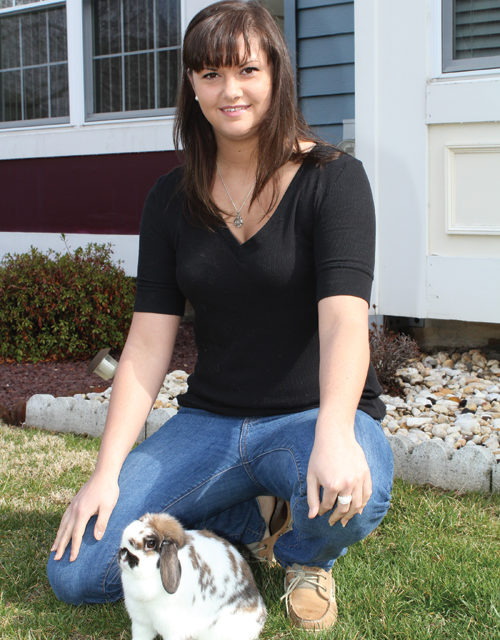
The “Year of the Rabbit,” says Hampstead rabbit breeder Ashlee Richards, is “having a major impact in Asia.”
Written By Scott Braden
As the snow melts and spring comes, nature signals the time of bunnies – or more specifically, the Easter Bunny. This elusive creature, according to Wikipedia, “was introduced to the United States by German settlers who arrived in the Pennsylvania Dutch country during the 18th century.” In fact, the coming of the “Osterhase” is still considered one of childhood’s greatest pleasures, comparable to the arrival of Santa Claus on Christmas Eve.
And with the popularity of the Easter Bunny, combined with 2011 as the Chinese “Year of the Rabbit” – in the words of Yosemite Sam – “it seems these varmints are hotter than hotcakes!”
“The ÔYear of the Rabbit’ has made some news in the United States,” said Hampstead rabbit breeder Ashlee Richards, “but only really in accessory sales. One of my good friends has a ÔYear of the Rabbit’ water bottle she just purchased at a rabbit show.
“But the ÔYear of the Rabbit’ is having a major impact in Asia,” said Richards. “I have one friend in Malaysia whose rabbitry is being featured in several magazines to commemorate the ÔYear of the Rabbit.’ I have another friend from Singapore who helped organize a rabbit exhibit at the Singapore Zoo to celebrate the occasion.”
Rabbits stand for more than just cute and cuddly pets, especially on Easter. The Catholic Encyclopedia, for example, states that the “rabbit is a pagan symbol and has always been an emblem of fertility.”
“I think rabbits are a symbol of Easter because they are a sign of springtime,” said Richards. “In the wild, rabbits start delivering babies in early spring, so by Easter it seems that there are baby bunnies running around everywhere.”
So what is it like to be a bunny breeder at Easter time; or for that matter, any time? Kevin Brown, the leader of the Carroll County 4-H Rabbit Club, says breeders raise rabbits for show and rabbit meat (great for people fighting high cholesterol). And of course, there is the Rabbit Hopping:
“We’re starting a new program called Rabbit Hopping,” said Brown. “Rabbit Hopping is like an equestrian event for rabbits. You build your own jumps. It’s big in Denmark. There’s nobody in the U.S. who I know is doing it right now, and I’ve been dealing with some people in Calgary, Canada, on building some jumps and getting kids involved. So we’re going to start to breed some rabbits for that.”
“Being a rabbit breeder is like any other job,” said Richards. “There are different concerns and special chores that need to be done daily. For example, in the summer, it is important to keep fans cleaned and insects under control. “In the wintertime, it’s important to keep water thawed so that the rabbits have drinking water. I have a herd of about 60 rabbits and I spend about 20 hours a week caring for them.
“Easter time can be especially stressful because that’s usually the time when my rabbits start delivering spring litters.
“I usually do not sell rabbits as Easter presents,” said Richards. “In the past I have found that people buy Easter rabbits on a whim and don’t plan for when those rabbits grow up. In fact I don’t usually sell pet rabbits. The animals I breed are for showing purposes.”
Brown has a similar philosophy about selling bunnies during Easter.
“We don’t breed too many rabbits for Easter,” said Brown, “Because people look at giving the rabbit to their kids because it’s symbolic for the holiday. But after Easter, the children lose interest and want to bring the bunnies back. Taking care of rabbits is a commitment.
“But even if you limit the number of people who have rabbits, it’s still hard to stop the critters from procreating. So, if you started with one male and one female rabbit, how long would it take you to get wall-to-wall rabbits? Or to cover Maryland with them?
“Rabbits are ready to breed in six months,” said Brown. “And once you put a male and female together, they can have anywhere between five to 10 babies. I’ve had some that have had a lot more that that. You can do the math.
In 1859, two domestic rabbits were released in Australia and within 10 years there were over 2 million feral rabbits in Australia.”
How many varieties of rabbits are there?
“Each breed of rabbit has its own set of accepted varieties,” said Richards, “and there are 47 breeds, so that number will vary from breed to breed. The breed I raise, the Holland Lop, comes in 27 varieties.
“I breed rabbits because I love animals and competition. I got started in rabbits when I was 8 years old and joined 4-H. I wanted an animal project, but I didn’t have the room for livestock so my mother let me get a rabbit. I was hooked. Another reason I raise rabbits is because of the friendships I’ve made over the years with fellow breeders. I love going to shows to talk to friends just as much as I love going to show my rabbits.”

